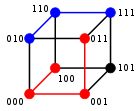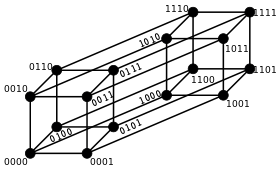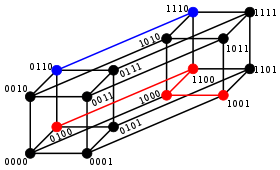Hamming distance
 3-bit binary cube for finding Hamming distance |
 Two example distances: 100→011 has distance 3 (red path); 010→111 has distance 2 (blue path) |
 4-bit binary tesseract for finding Hamming distance | |
 Two example distances: 0100→1001 has distance 3 (red path); 0110→1110 has distance 1 (blue path) | |
In information theory, the Hamming distance between two strings of equal length is the number of positions at which the corresponding symbols are different. In another way, it measures the minimum number of substitutions required to change one string into the other, or the minimum number of errors that could have transformed one string into the other.
A major application is in coding theory, more specifically to block codes, in which the equal-length strings are vectors over a finite field.
Examples
The Hamming distance between:
- "karolin" and "kathrin" is 3.
- "karolin" and "kerstin" is 3.
- 1011101 and 1001001 is 2.
- 2173896 and 2233796 is 3.
Properties
For a fixed length n, the Hamming distance is a metric on the set of the words of length n (also known as a Hamming space), as it fulfills the conditions of non-negativity, identity of indiscernibles and symmetry, and it can be shown by complete induction that it satisfies the triangle inequality as well.[1] The Hamming distance between two words a and b can also be seen as the Hamming weight of a−b for an appropriate choice of the − operator.
For binary strings a and b the Hamming distance is equal to the number of ones (population count) in a XOR b. The metric space of length-n binary strings, with the Hamming distance, is known as the Hamming cube; it is equivalent as a metric space to the set of distances between vertices in a hypercube graph. One can also view a binary string of length n as a vector in  by treating each symbol in the string as a real coordinate; with this embedding, the strings form the vertices of an n-dimensional hypercube, and the Hamming distance of the strings is equivalent to the Manhattan distance between the vertices.
by treating each symbol in the string as a real coordinate; with this embedding, the strings form the vertices of an n-dimensional hypercube, and the Hamming distance of the strings is equivalent to the Manhattan distance between the vertices.
Error detection and error correction
The Hamming distance is used to define some essential notions in coding theory, such as error detecting and error correcting codes. In particular, a code C is said to be k-errors detecting if any two codewords c1 and c2 from C that have a Hamming distance less than k coincide; otherwise, a code is k-errors detecting if, and only if, the minimum Hamming distance between any two of its codewords is at least k+1.[1]
A code C is said to be k-errors correcting if, for every word w in the underlying Hamming space H, there exists at most one codeword c (from C) such that the Hamming distance between w and c is less than k. In other words, a code is k-errors correcting if, and only if, the minimum Hamming distance between any two of its codewords is at least 2k+1. This is more easily understood geometrically as any closed balls of radius k centered on distinct codewords being disjoint.[1] These balls are also called Hamming spheres in this context.[2]
Thus a code with minimum Hamming distance d between its codewords can detect at most d-1 errors and can correct ⌊(d-1)/2⌋ errors.[1] The latter number is also called the packing radius or the error-correcting capability of the code.[2]
History and applications
The Hamming distance is named after Richard Hamming, who introduced it in his fundamental paper on Hamming codes Error detecting and error correcting codes in 1950.[3] Hamming weight analysis of bits is used in several disciplines including information theory, coding theory, and cryptography.
It is used in telecommunication to count the number of flipped bits in a fixed-length binary word as an estimate of error, and therefore is sometimes called the signal distance.[4] For q-ary strings over an alphabet of size q ≥ 2 the Hamming distance is applied in case of the q-ary symmetric channel, while the Lee distance is used for phase-shift keying or more generally channels susceptible to synchronization errors because the Lee distance accounts for errors of ±1.[5] If q = 2 or q = 3 both distances coincide because Z/2Z and Z/3Z are also fields, but Z/4Z is not a field but only a ring.
The Hamming distance is also used in systematics as a measure of genetic distance.[6]
However, for comparing strings of different lengths, or strings where not just substitutions but also insertions or deletions have to be expected, a more sophisticated metric like the Levenshtein distance is more appropriate.
Algorithm example
The Python3 function hammingDistance() computes the Hamming distance between
two strings (or other iterable objects) of equal length, by creating a sequence of Boolean values indicating mismatches and matches between corresponding positions in the two inputs, and then summing the sequence with False and True values being interpreted as zero and one.
def hammingDistance(s1, s2):
"""Return the Hamming distance between equal-length sequences"""
if len(s1) != len(s2):
raise ValueError("Undefined for sequences of unequal length")
return sum(bool(ord(ch1) - ord(ch2)) for ch1, ch2 in zip(s1, s2))
Or in Ruby language the function hammingDistance() could be:
def hammingDistance(s1, s2)
raise "ERROR: Hamming: Non equal lengths" if s1.length != s2.length
(s1.chars.zip(s2.chars)).count {|l, r| l != r}
end
The following C function will compute the Hamming distance of two integers (considered as binary values, that is, as sequences of bits). The running time of this procedure is proportional to the Hamming distance rather than to the number of bits in the inputs. It computes the bitwise exclusive or of the two inputs, and then finds the Hamming weight of the result (the number of nonzero bits) using an algorithm of Wegner (1960) that repeatedly finds and clears the lowest-order nonzero bit. Some compilers support the __builtin_popcount function which can calculate this using specialized processor hardware where available.
int hamming_distance(unsigned x, unsigned y)
{
int dist = 0;
unsigned val = x ^ y;
// Count the number of bits set
while (val != 0)
{
// A bit is set, so increment the count and clear the bit
dist++;
val &= val - 1;
}
// Return the number of differing bits
return dist;
}
See also
- Closest string
- Damerau–Levenshtein distance
- Euclidean distance
- Mahalanobis distance
- Jaccard index
- String metric
- Sørensen similarity index
- Word ladder
- Gray code
Notes
- 1 2 3 4 Derek J.S. Robinson (2003). An Introduction to Abstract Algebra. Walter de Gruyter. pp. 255–257. ISBN 978-3-11-019816-4.
- 1 2 Cohen, G.; Honkala, I.; Litsyn, S.; Lobstein, A. (1997), Covering Codes, North-Holland Mathematical Library 54, Elsevier, pp. 16–17, ISBN 9780080530079
- ↑ Hamming (1950).
- ↑ Jose Ayala (2012). Integrated Circuit and System Design. Springer. p. 62. ISBN 978-3-642-36156-2.
- ↑ Ron Roth (2006). Introduction to Coding Theory. Cambridge University Press. p. 298. ISBN 978-0-521-84504-5.
- ↑ Pilcher, Wong & Pillai (2008).
References
 This article incorporates public domain material from the General Services Administration document "Federal Standard 1037C".
This article incorporates public domain material from the General Services Administration document "Federal Standard 1037C".- Hamming, Richard W. (1950), "Error detecting and error correcting codes" (PDF), Bell System Technical Journal 29 (2): 147–160, doi:10.1002/j.1538-7305.1950.tb00463.x, MR 0035935.
- Pilcher, C. D.; Wong, J. K.; Pillai, S. K. (March 2008), "Inferring HIV transmission dynamics from phylogenetic sequence relationships", PLoS Med. 5 (3): e69, doi:10.1371/journal.pmed.0050069, PMC 2267810, PMID 18351799.
- Wegner, Peter (1960), "A technique for counting ones in a binary computer", Communications of the ACM 3 (5): 322, doi:10.1145/367236.367286.
- Ayala, Jose (2012), "Fast Propagation of Hamming and Signal Distances for Register-Transfer Level Datapaths", Integrated Circuit and System Design 1: 62.
| ||||||||||||||||||||||||||||||